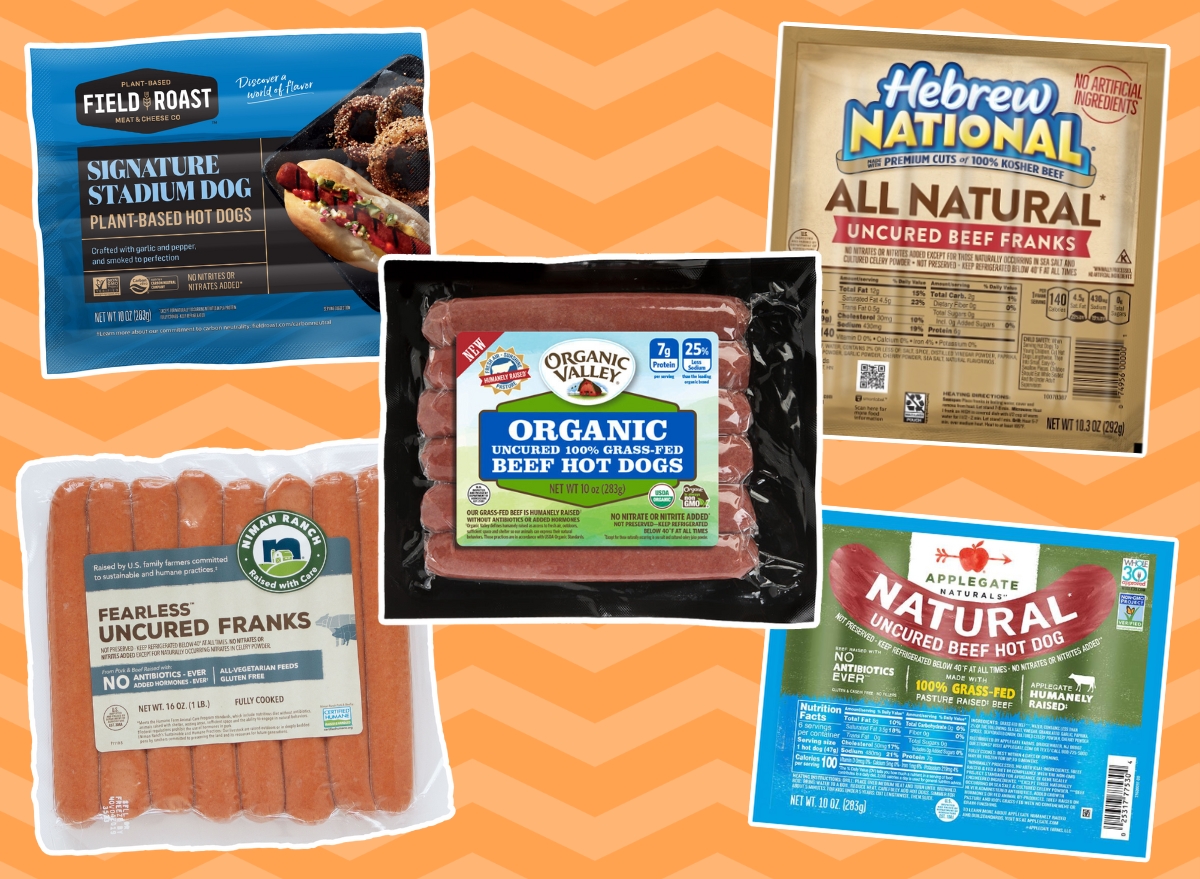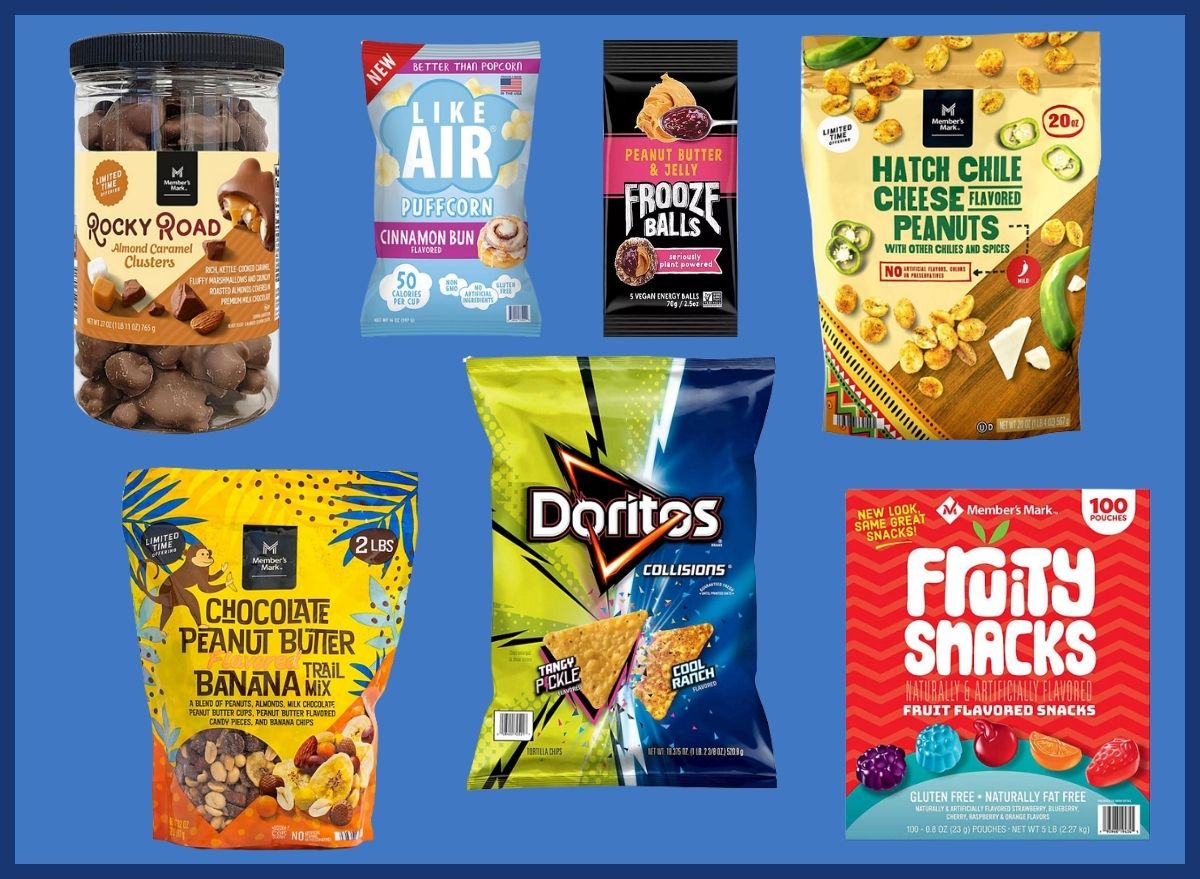The product recommendations in this post are recommendations by the writer and/or expert(s)
interviewed and do not contain affiliate links. Meaning: If you use these links to buy
something, we will not earn a commission.
Hot dogs get a bad rap because they’re traditionally made with processed red meat and are high in sodium and saturated fat — two nutrients linked to poor health. But that doesn’t mean you have to shun frankfurters this barbecue season. “Hot dogs aren’t perfect foods, but they are fun summertime food, and I encourage my clients to enjoy them on occasion,” says Jaime Windrow, RD, LDN, a registered dietitian with Top Nutrition Coaching.
While it’s A-OK to enjoy a few vendor hot dogs here and there, there are many healthier hot dog brands that you can add to your cart and make at home more often. And these souped-up sausages are actually not too shabby in the nutrition department: Many of these healthy hot dogs are lower in sodium and free from artificial additives. Plus, many are made with leaner cuts of meat or plant-based ingredients, reducing the overall fat content, Windrow says.
How to choose the best hot dog at the grocery store:
Before throwing any pack of hot dogs into your cart, Windrow shares what you should look for on labels to get the highest-quality hot dog you can buy at the grocery store.
- Uncured and nitrate-free: Look for hot dogs that leave out synthetic preservatives.
- Whole meats vs. mechanically processed ingredients: Read ingredient lists and look for products that have whole beef, turkey or chicken, and avoid those with mechanically processed and separated meats.
- Short ingredient list: Choose a hot dog with a short ingredient list. Higher-quality hot dogs will have minimal ingredients
- 4 grams of saturated fat or less: Choose a hot dog with less than 4 grams of saturated fat, ideally
- 500 milligrams of sodium or less: Choose a hot dog with less than 500 milligrams of sodium per serving (and look at the total fat content — often “light” hot dogs are higher in sodium and may therefore not be more nutritious)
- Regular vs. jumbo- or ballpark-sized: Try to avoid buying oversized hot dogs, as they’ll likely have more of the nutrients you don’t want (i.e. sodium and saturated fat)
Below, find the best hot dogs with the highest-quality ingredients to throw on the grill this summer. And then, don’t miss What Happens to Your Body When You Eat a Hot Dog.
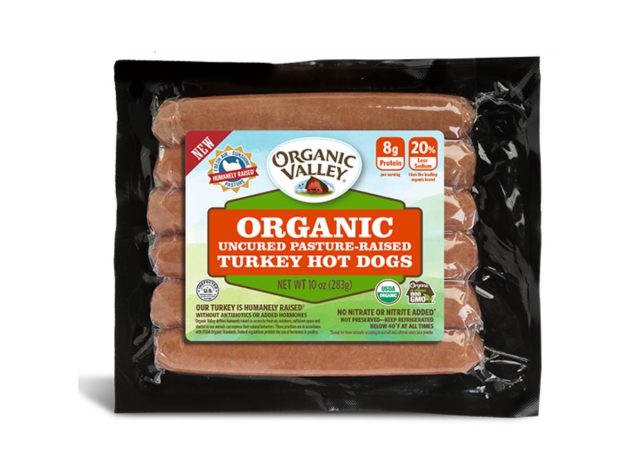

Per hot dog: 60 calories, 3 g fat (1 g saturated fat), 350 mg sodium, 0 g carbs, 8 g protein
Windrow recommends these turkey hot dogs because they check all of the boxes: They’re organic, uncured, made out of humanely pasture-raised turkey, and are lower in sodium than most frankfurters. Plus, the ingredient list is super minimal — aside from turkey, this summertime staple contains just a blend of spices — so feel free to throw a couple on the grill alongside some corn on the cob and skewered veggies for lunch.
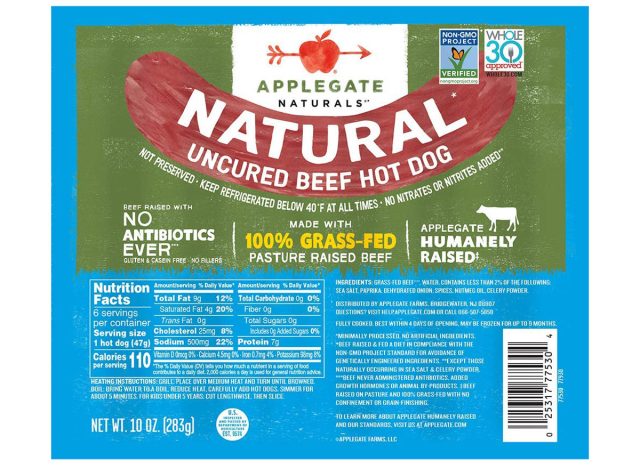

Per hot dog: 100 calories, 8 g fat (3.5 g saturated fat), 480 mg sodium, 0 g carbs, 7 g protein
If you’re looking for the closest thing to a stadium-style hot dog, Windrow recommends Applegate Naturals’ Uncured Beef Hot Dogs. They’re plump, juicy, and delicious — plus, they’re made with grass-fed, regeneratively sourced beef and a blend of spices. We also love that these are sugar-free and cook up in just 5 minutes.
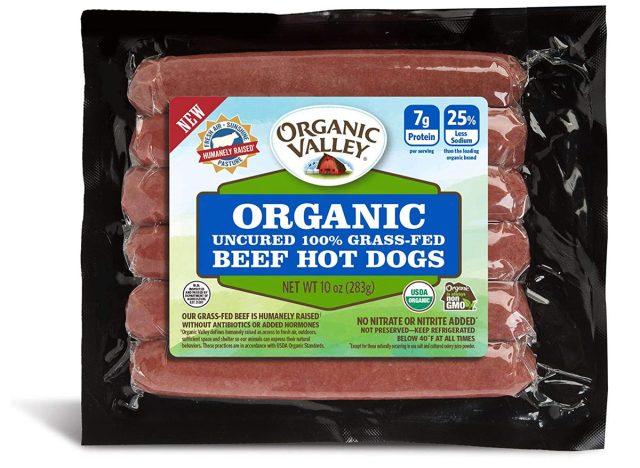

Per hot dog: 130 calories, 11 g fat (4 g saturated fat), 370 mg sodium, 0 g carbs, 7 g protein
Another pick from Organic Valley that comes recommended from Windrow, these grass-fed beef hot dogs are equally delicious as they are nutritious. The hardwood-smoked beef is simply spiced with garlic and onion powder. These are made without antibiotics, synthetic hormones, or pesticides; and they boast a minimal ingredient list, so you can feel good about feeding these to your family.
READ RELATED: How Is Anxiety Different From Stress? Explains Life Coach
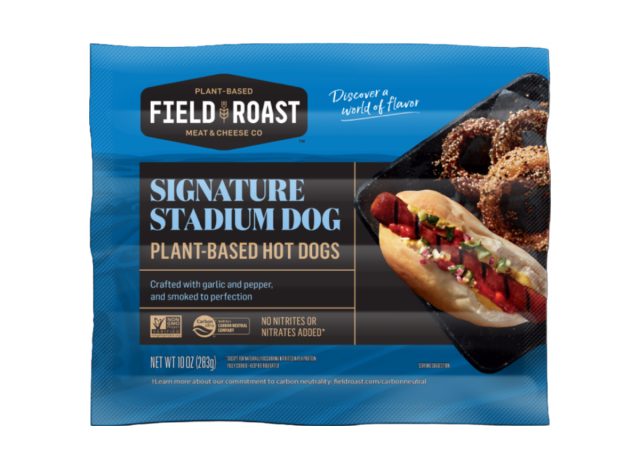

Per hot dog: 110 calories, 7 g fat (0.5 g saturated fat), 310 mg sodium, 7 g carbs (1 g fiber, <1 g sugar), 5 g protein
Field Roast hot dogs are a plant-based, flavorful alternative to traditional beef hot dogs, and they look and cook like the real thing! Windrow recommends these vegan hot dogs because they contain just 310 milligrams of sodium and less than 1 gram of saturated fat. One link has 5 grams of plant protein coming from peas and fava beans.
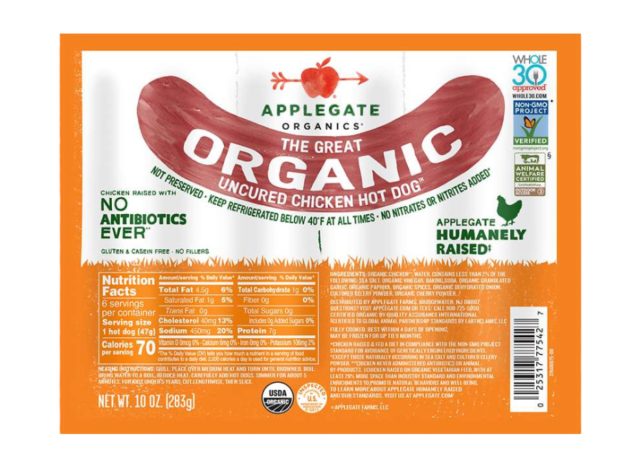

Per hot dog: 70 calories, 4.5 g fat (1 g saturated fat), 450 mg sodium, 1 g carbs (0 g fiber, 0 g sugar), 7 g protein
Applegate Organics’ Uncured Chicken Hot Dogs are uncured and low in saturated fat, which is why they come recommended by Windrow. Plus, one hot dog contains 7 grams of protein for just 70 calories. Sandwich one of these poultry hot dogs between a whole-grain bun and top with mustard and sauerkraut for a tasty lunch that’s guaranteed to be a hit.
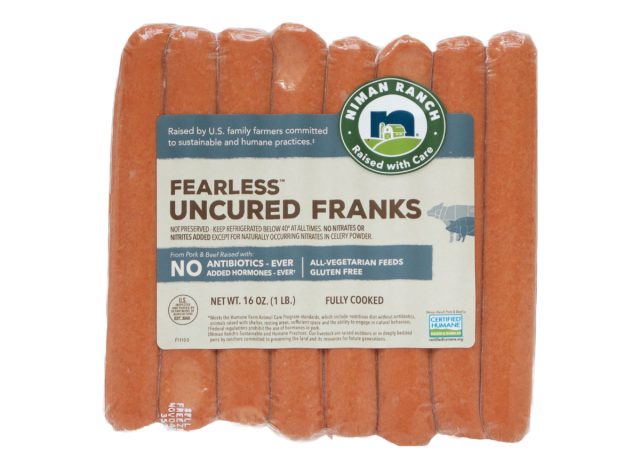

Per hot dog: 130 calories, 9 g fat (3.5 g saturated fat), 480 mg sodium, 1 g carbs (0 g fiber, 0 g sugar), 8 g protein
If you’re on the hunt for a traditional beef-and-pork hot dog, Windrow recommends these from Niman Ranch, a company that sources its meat only from small, independent U.S. family farmers and ranchers who raise their livestock humanely and sustainably. These frankfurters are uncured and clock in under Windrow’s suggested sodium and saturated fat limits, so feel free to grab a pack and get grilling.
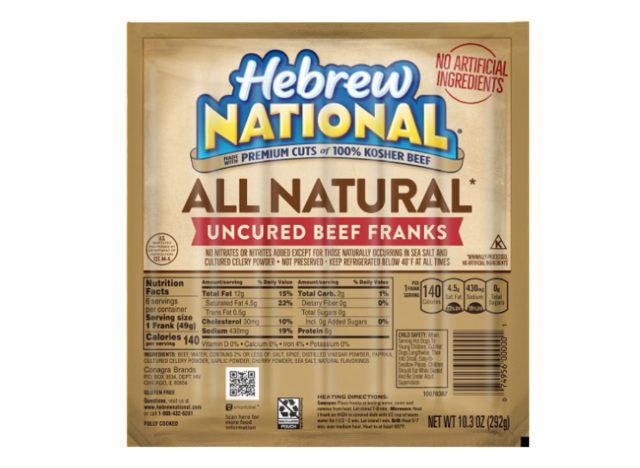

Per hot dog: 140 calories, 12 g fat (4.5 g saturated fat), 430 mg sodium, 1 g carbs (0 g fiber, 0 g sugar), 6 g protein
These Hebrew National hot dogs deliver that classic frankfurter flavor you know and love minus all the stuff you don’t. There’s no added nitrates or nitrites, and these links have less than 500 milligrams of sodium and 5 grams of saturated fat per serving, fitting Windrow’s nutritional parameters. Plus, we love that these are widely available in many grocery stores.
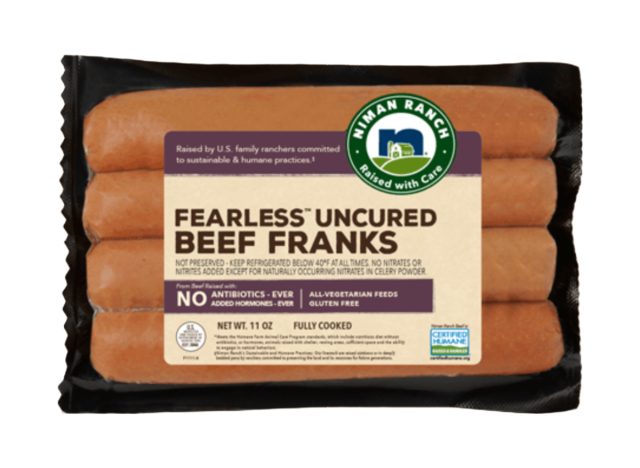

Per hot dog: 170 calories, 13 g fat (5 g saturated fat), 630 mg sodium, 1 g carbs (0 g fiber, 0 g sugar), 12 g protein
These Niman Ranch Fearless Uncured Beef Franks are really beefy, coming in at 170 calories and 12 grams of protein. While they contain 5 grams of saturated fat and 630 milligrams of sodium, they don’t exactly fit Windrow’s nutritional criteria to a T. “These are much larger than the Organic Valley and Applegate dogs, hence the fat sodium being higher,” Windrow notes.
However, their minimal ingredient list and the fact that they’re uncured and have no MSG, fillers, or byproducts deem these a good choice, according to Windrow.

